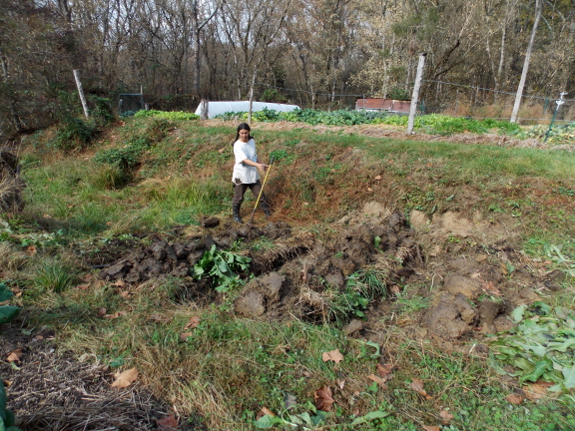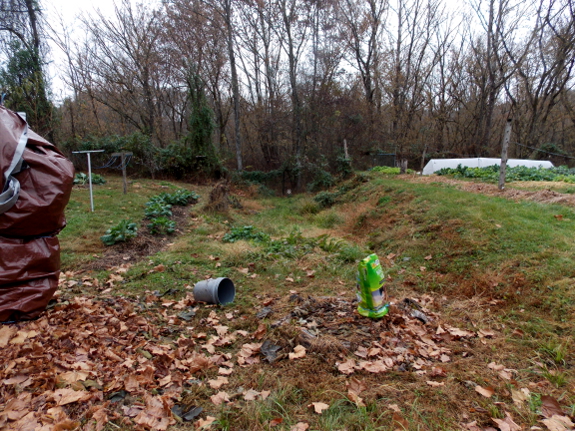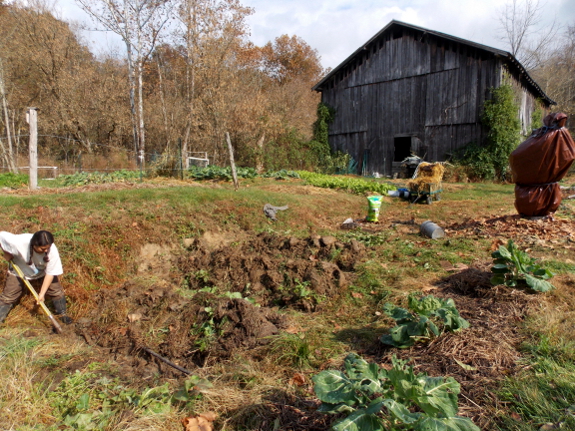
Backyard terraforming

'Tis the season to be terraforming, tra la la la la, la la la la....
That early killing frost
was the bane of my fall garden, but a boon to future gardens. By
nipping back a lot of the current growth, the hard frost made it easy to
dig while it's still early enough that I can probably sneak rye seeds
in to cover the bare ground for the winter. I decided to take
advantage of the opportunity by terraforming the upper quarter of the
gully.
Long-time readers will be
aware that this gully probably formed when previous owners of our farm
let all the topsoil erode away from half of our core homestead.
The result is a swampy, weedy area that Mark has been slowly reclaiming with hand saws, clippers, and weedeaters for the last few years.
By
this time last year, the upper quarter of the gully had changed from
briers to sedges and grasses, so I figured it was safe to throw down a kill mulch
and grow subirrigated tomatoes there this year. The idea made
sense, but I wasn't aware how swampy that part of the gully becomes
during a wet summer, so the tomatoes caught the blight quickly and perished.
My current method for dealing with parts of the garden that make me sad
is to avert my eyes and go somewhere else (not recommended), so I never
weeded the tomato beds after the crop died, and moderate weeds started
coming back in.

This week's task was to
ensure that the next crop planted in that part of the gully doesn't
drown, achieved by mounding all the topsoil from the aisles onto the
beds. These rows may turn out to be a set of chinampas in wet years, but I'm willing to weed in muck boots if that's what it takes to turn this sunny spot into a productive part of the garden.

And the results already
thrill me! I shouldn't have been so surprised when each shovelful
of dirt came up dark and rich --- after all, if the topsoil eroded out
of the gardens above, it had to collect somewhere, right? Since
the roots of the plants in these new raised beds won't be submerged in
water any longer, I suspect this might become one of my best growing
areas.
Next up on the
terraforming list is some swales in the newest pasture, and kill
mulching another zone of the gully so it'll be just as easy to dig next
year as this zone was. The gully is definitely shaping up to be
one of our longest-term projects, but worth the tidbits of attention
here and there devoted to the oft-ignored corner.
Want more in-depth information? Browse through our books.
Or explore more posts by date or by subject.
About us: Anna Hess and Mark Hamilton spent over a decade living self-sufficiently in the mountains of Virginia before moving north to start over from scratch in the foothills of Ohio. They've experimented with permaculture, no-till gardening, trailersteading, home-based microbusinesses and much more, writing about their adventures in both blogs and books.
Want to be notified when new comments are posted on this page? Click on the RSS button after you add a comment to subscribe to the comment feed, or simply check the box beside "email replies to me" while writing your comment.

It is hard to tell in the photos, but does the gully have an outlet, and did you make the "chinampas" parallel or perpendicular to the grade? Or, "Will It Drain?"
A nice piece of ag drain might make it even nicer if there is an accessible outlet.